Leadership Report: Courageous Leadership and Styles Analysis
VerifiedAdded on 2020/05/28
|12
|4118
|45
Report
AI Summary
This report examines the concept of courageous leadership, emphasizing its crucial role in overcoming challenges and driving organizational success. It outlines the key characteristics of courageous leaders, such as embracing reality, communicating effectively, taking decisive action, and accepting accountability. The report then compares courageous leadership with other prominent styles, including situational, transformational, and charismatic leadership, highlighting the strengths and applications of each. Situational leadership is presented as adaptive, transformational leadership as goal-oriented, and charismatic leadership as based on personality. The report also includes a self-assessment of the author's own courageous leadership capabilities, providing a comprehensive analysis of leadership styles and their practical implications.
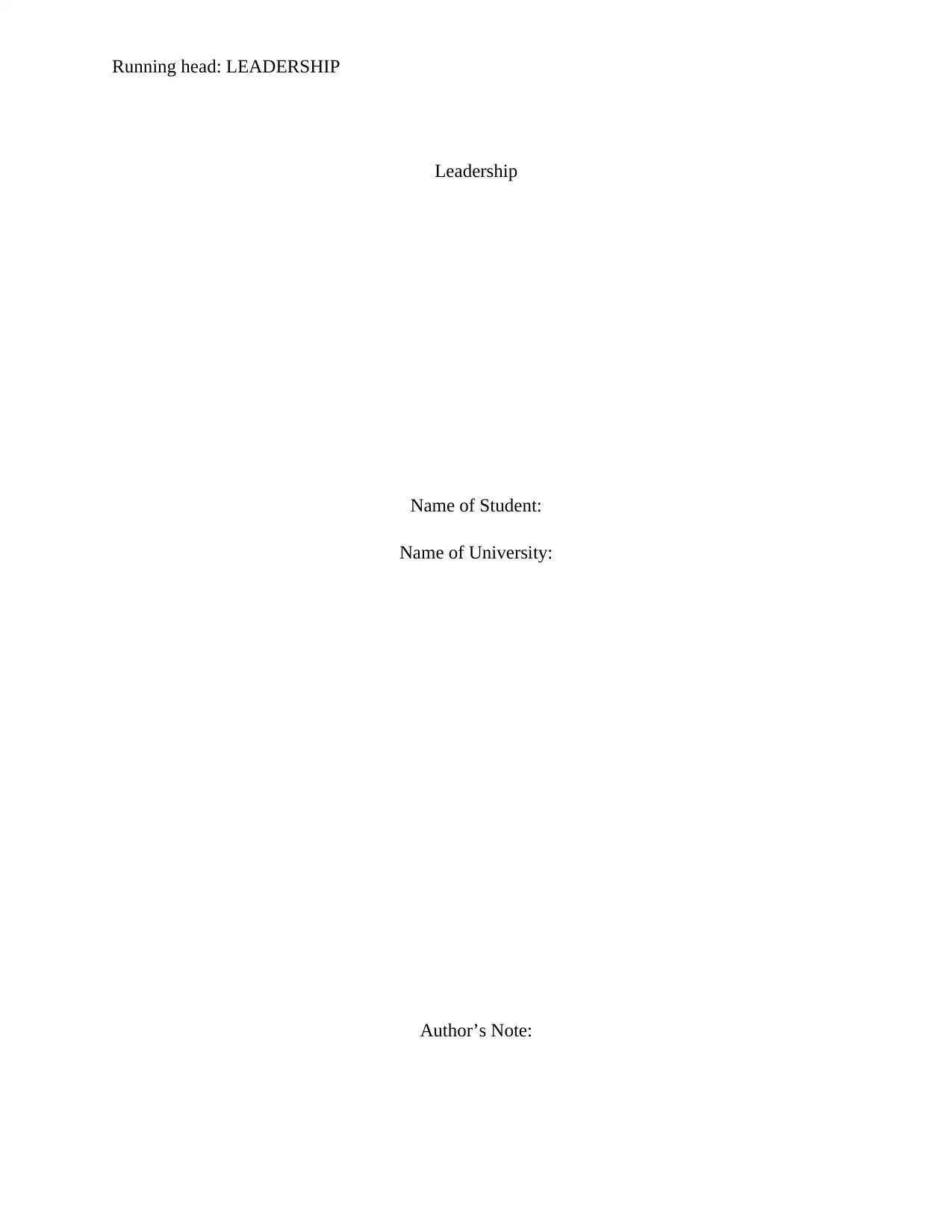
Running head: LEADERSHIP
Leadership
Name of Student:
Name of University:
Author’s Note:
Leadership
Name of Student:
Name of University:
Author’s Note:
Paraphrase This Document
Need a fresh take? Get an instant paraphrase of this document with our AI Paraphraser
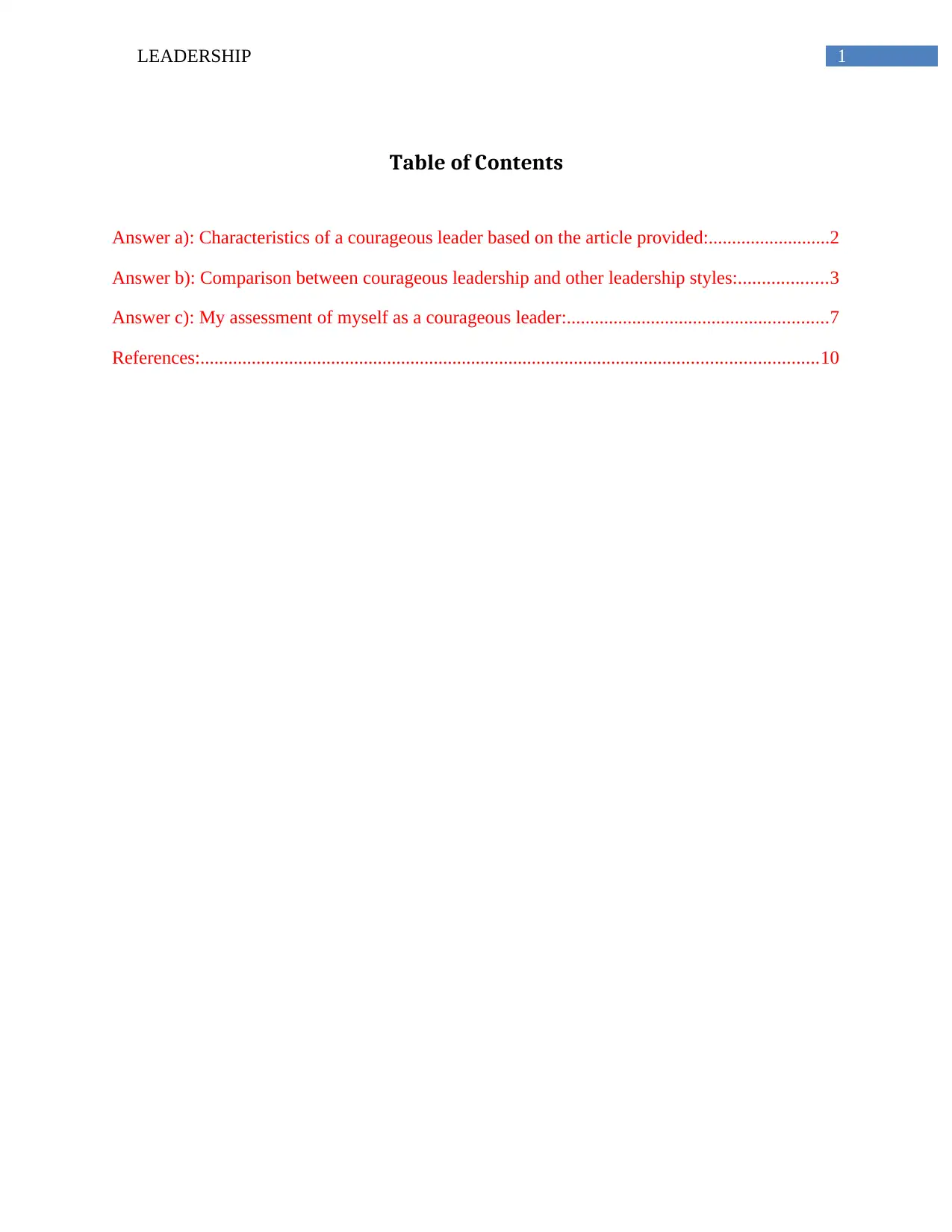
1LEADERSHIP
Table of Contents
Answer a): Characteristics of a courageous leader based on the article provided:..........................2
Answer b): Comparison between courageous leadership and other leadership styles:...................3
Answer c): My assessment of myself as a courageous leader:........................................................7
References:....................................................................................................................................10
Table of Contents
Answer a): Characteristics of a courageous leader based on the article provided:..........................2
Answer b): Comparison between courageous leadership and other leadership styles:...................3
Answer c): My assessment of myself as a courageous leader:........................................................7
References:....................................................................................................................................10
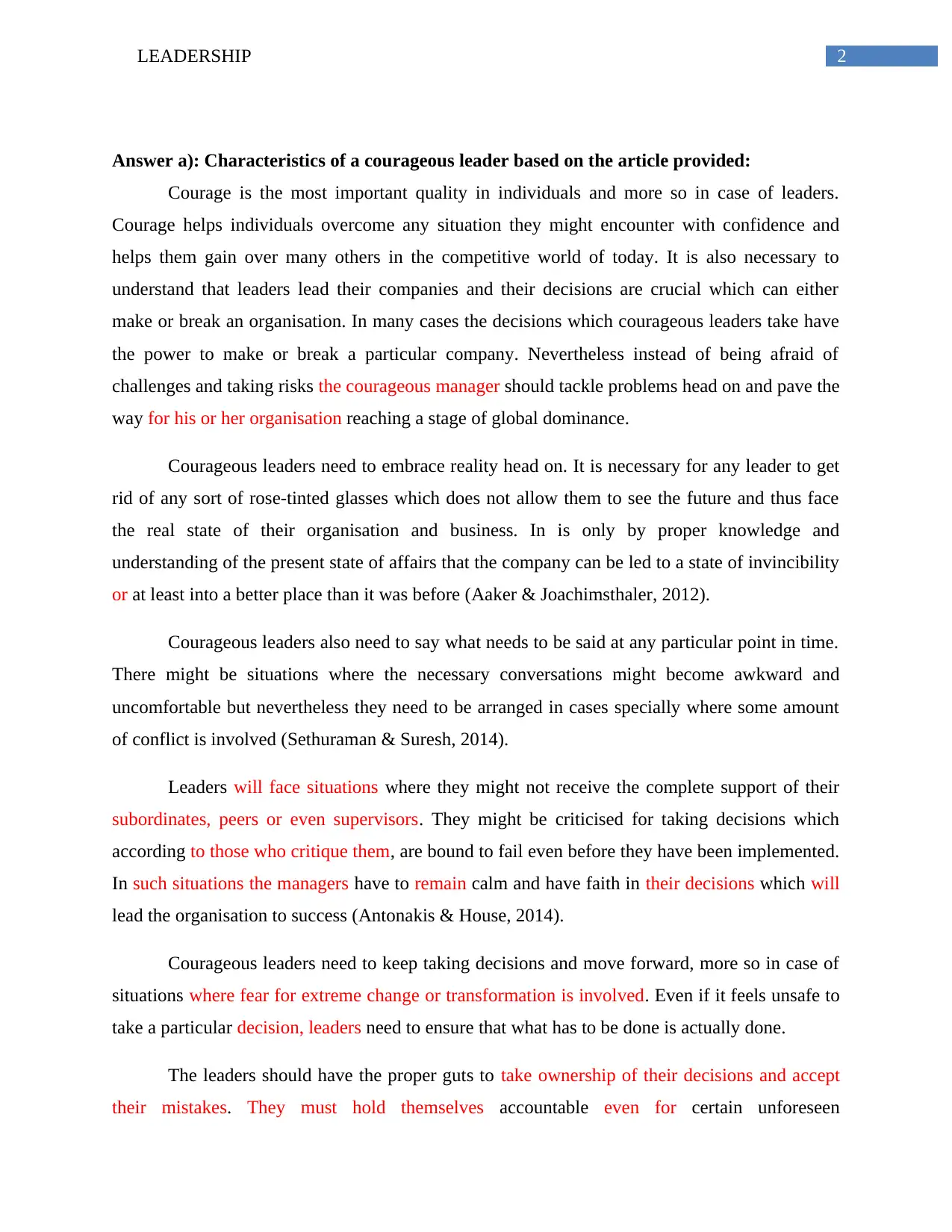
2LEADERSHIP
Answer a): Characteristics of a courageous leader based on the article provided:
Courage is the most important quality in individuals and more so in case of leaders.
Courage helps individuals overcome any situation they might encounter with confidence and
helps them gain over many others in the competitive world of today. It is also necessary to
understand that leaders lead their companies and their decisions are crucial which can either
make or break an organisation. In many cases the decisions which courageous leaders take have
the power to make or break a particular company. Nevertheless instead of being afraid of
challenges and taking risks the courageous manager should tackle problems head on and pave the
way for his or her organisation reaching a stage of global dominance.
Courageous leaders need to embrace reality head on. It is necessary for any leader to get
rid of any sort of rose-tinted glasses which does not allow them to see the future and thus face
the real state of their organisation and business. In is only by proper knowledge and
understanding of the present state of affairs that the company can be led to a state of invincibility
or at least into a better place than it was before (Aaker & Joachimsthaler, 2012).
Courageous leaders also need to say what needs to be said at any particular point in time.
There might be situations where the necessary conversations might become awkward and
uncomfortable but nevertheless they need to be arranged in cases specially where some amount
of conflict is involved (Sethuraman & Suresh, 2014).
Leaders will face situations where they might not receive the complete support of their
subordinates, peers or even supervisors. They might be criticised for taking decisions which
according to those who critique them, are bound to fail even before they have been implemented.
In such situations the managers have to remain calm and have faith in their decisions which will
lead the organisation to success (Antonakis & House, 2014).
Courageous leaders need to keep taking decisions and move forward, more so in case of
situations where fear for extreme change or transformation is involved. Even if it feels unsafe to
take a particular decision, leaders need to ensure that what has to be done is actually done.
The leaders should have the proper guts to take ownership of their decisions and accept
their mistakes. They must hold themselves accountable even for certain unforeseen
Answer a): Characteristics of a courageous leader based on the article provided:
Courage is the most important quality in individuals and more so in case of leaders.
Courage helps individuals overcome any situation they might encounter with confidence and
helps them gain over many others in the competitive world of today. It is also necessary to
understand that leaders lead their companies and their decisions are crucial which can either
make or break an organisation. In many cases the decisions which courageous leaders take have
the power to make or break a particular company. Nevertheless instead of being afraid of
challenges and taking risks the courageous manager should tackle problems head on and pave the
way for his or her organisation reaching a stage of global dominance.
Courageous leaders need to embrace reality head on. It is necessary for any leader to get
rid of any sort of rose-tinted glasses which does not allow them to see the future and thus face
the real state of their organisation and business. In is only by proper knowledge and
understanding of the present state of affairs that the company can be led to a state of invincibility
or at least into a better place than it was before (Aaker & Joachimsthaler, 2012).
Courageous leaders also need to say what needs to be said at any particular point in time.
There might be situations where the necessary conversations might become awkward and
uncomfortable but nevertheless they need to be arranged in cases specially where some amount
of conflict is involved (Sethuraman & Suresh, 2014).
Leaders will face situations where they might not receive the complete support of their
subordinates, peers or even supervisors. They might be criticised for taking decisions which
according to those who critique them, are bound to fail even before they have been implemented.
In such situations the managers have to remain calm and have faith in their decisions which will
lead the organisation to success (Antonakis & House, 2014).
Courageous leaders need to keep taking decisions and move forward, more so in case of
situations where fear for extreme change or transformation is involved. Even if it feels unsafe to
take a particular decision, leaders need to ensure that what has to be done is actually done.
The leaders should have the proper guts to take ownership of their decisions and accept
their mistakes. They must hold themselves accountable even for certain unforeseen
⊘ This is a preview!⊘
Do you want full access?
Subscribe today to unlock all pages.

Trusted by 1+ million students worldwide
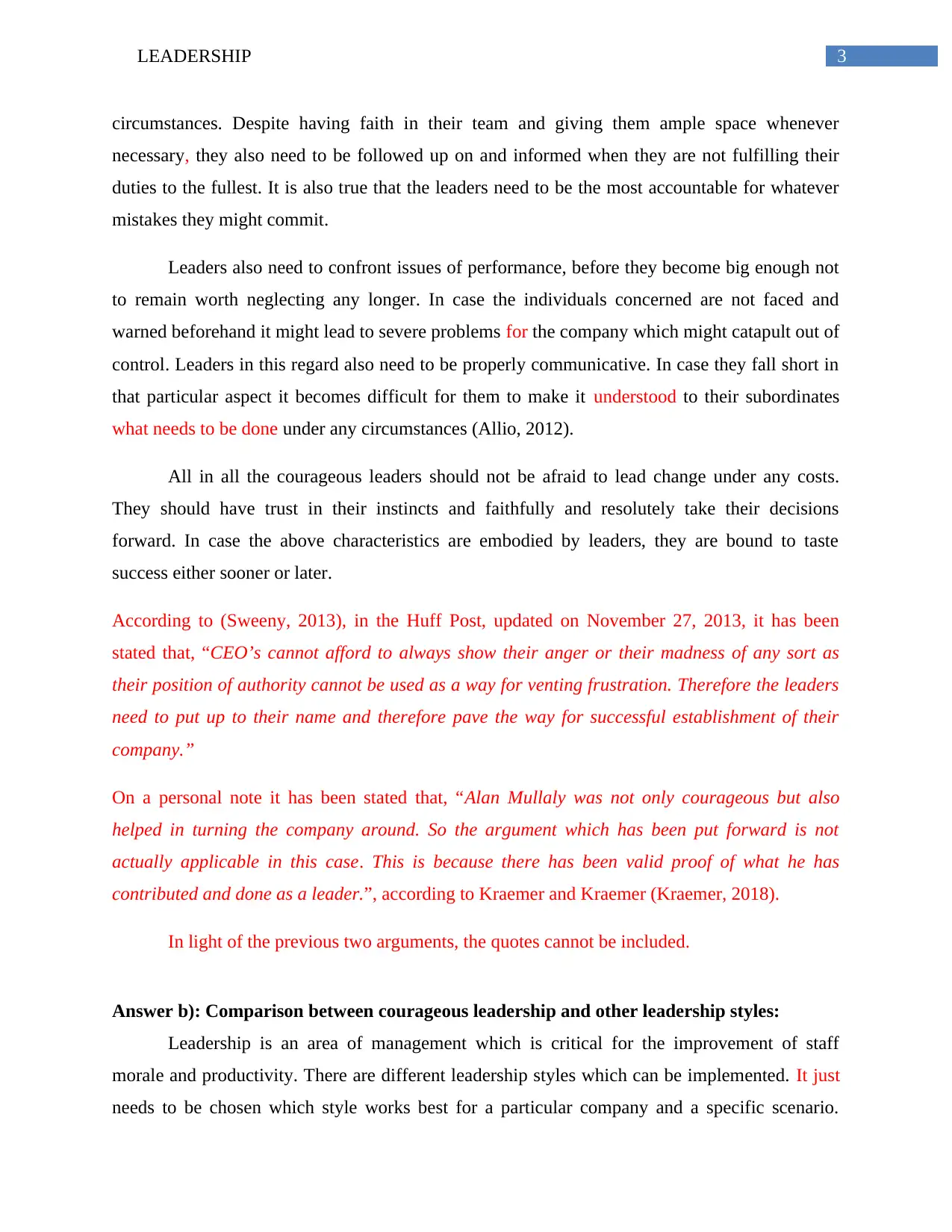
3LEADERSHIP
circumstances. Despite having faith in their team and giving them ample space whenever
necessary, they also need to be followed up on and informed when they are not fulfilling their
duties to the fullest. It is also true that the leaders need to be the most accountable for whatever
mistakes they might commit.
Leaders also need to confront issues of performance, before they become big enough not
to remain worth neglecting any longer. In case the individuals concerned are not faced and
warned beforehand it might lead to severe problems for the company which might catapult out of
control. Leaders in this regard also need to be properly communicative. In case they fall short in
that particular aspect it becomes difficult for them to make it understood to their subordinates
what needs to be done under any circumstances (Allio, 2012).
All in all the courageous leaders should not be afraid to lead change under any costs.
They should have trust in their instincts and faithfully and resolutely take their decisions
forward. In case the above characteristics are embodied by leaders, they are bound to taste
success either sooner or later.
According to (Sweeny, 2013), in the Huff Post, updated on November 27, 2013, it has been
stated that, “CEO’s cannot afford to always show their anger or their madness of any sort as
their position of authority cannot be used as a way for venting frustration. Therefore the leaders
need to put up to their name and therefore pave the way for successful establishment of their
company.”
On a personal note it has been stated that, “Alan Mullaly was not only courageous but also
helped in turning the company around. So the argument which has been put forward is not
actually applicable in this case. This is because there has been valid proof of what he has
contributed and done as a leader.”, according to Kraemer and Kraemer (Kraemer, 2018).
In light of the previous two arguments, the quotes cannot be included.
Answer b): Comparison between courageous leadership and other leadership styles:
Leadership is an area of management which is critical for the improvement of staff
morale and productivity. There are different leadership styles which can be implemented. It just
needs to be chosen which style works best for a particular company and a specific scenario.
circumstances. Despite having faith in their team and giving them ample space whenever
necessary, they also need to be followed up on and informed when they are not fulfilling their
duties to the fullest. It is also true that the leaders need to be the most accountable for whatever
mistakes they might commit.
Leaders also need to confront issues of performance, before they become big enough not
to remain worth neglecting any longer. In case the individuals concerned are not faced and
warned beforehand it might lead to severe problems for the company which might catapult out of
control. Leaders in this regard also need to be properly communicative. In case they fall short in
that particular aspect it becomes difficult for them to make it understood to their subordinates
what needs to be done under any circumstances (Allio, 2012).
All in all the courageous leaders should not be afraid to lead change under any costs.
They should have trust in their instincts and faithfully and resolutely take their decisions
forward. In case the above characteristics are embodied by leaders, they are bound to taste
success either sooner or later.
According to (Sweeny, 2013), in the Huff Post, updated on November 27, 2013, it has been
stated that, “CEO’s cannot afford to always show their anger or their madness of any sort as
their position of authority cannot be used as a way for venting frustration. Therefore the leaders
need to put up to their name and therefore pave the way for successful establishment of their
company.”
On a personal note it has been stated that, “Alan Mullaly was not only courageous but also
helped in turning the company around. So the argument which has been put forward is not
actually applicable in this case. This is because there has been valid proof of what he has
contributed and done as a leader.”, according to Kraemer and Kraemer (Kraemer, 2018).
In light of the previous two arguments, the quotes cannot be included.
Answer b): Comparison between courageous leadership and other leadership styles:
Leadership is an area of management which is critical for the improvement of staff
morale and productivity. There are different leadership styles which can be implemented. It just
needs to be chosen which style works best for a particular company and a specific scenario.
Paraphrase This Document
Need a fresh take? Get an instant paraphrase of this document with our AI Paraphraser
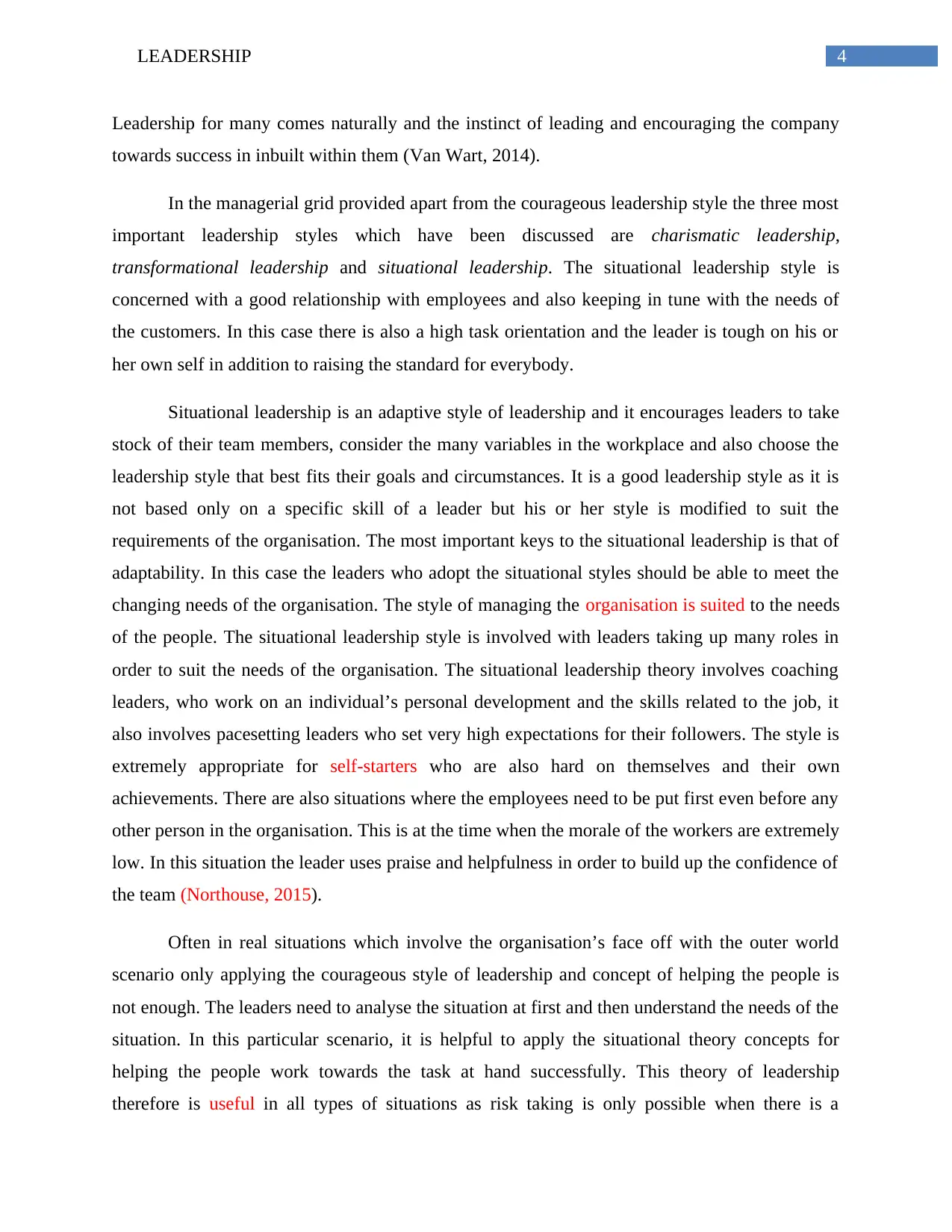
4LEADERSHIP
Leadership for many comes naturally and the instinct of leading and encouraging the company
towards success in inbuilt within them (Van Wart, 2014).
In the managerial grid provided apart from the courageous leadership style the three most
important leadership styles which have been discussed are charismatic leadership,
transformational leadership and situational leadership. The situational leadership style is
concerned with a good relationship with employees and also keeping in tune with the needs of
the customers. In this case there is also a high task orientation and the leader is tough on his or
her own self in addition to raising the standard for everybody.
Situational leadership is an adaptive style of leadership and it encourages leaders to take
stock of their team members, consider the many variables in the workplace and also choose the
leadership style that best fits their goals and circumstances. It is a good leadership style as it is
not based only on a specific skill of a leader but his or her style is modified to suit the
requirements of the organisation. The most important keys to the situational leadership is that of
adaptability. In this case the leaders who adopt the situational styles should be able to meet the
changing needs of the organisation. The style of managing the organisation is suited to the needs
of the people. The situational leadership style is involved with leaders taking up many roles in
order to suit the needs of the organisation. The situational leadership theory involves coaching
leaders, who work on an individual’s personal development and the skills related to the job, it
also involves pacesetting leaders who set very high expectations for their followers. The style is
extremely appropriate for self-starters who are also hard on themselves and their own
achievements. There are also situations where the employees need to be put first even before any
other person in the organisation. This is at the time when the morale of the workers are extremely
low. In this situation the leader uses praise and helpfulness in order to build up the confidence of
the team (Northouse, 2015).
Often in real situations which involve the organisation’s face off with the outer world
scenario only applying the courageous style of leadership and concept of helping the people is
not enough. The leaders need to analyse the situation at first and then understand the needs of the
situation. In this particular scenario, it is helpful to apply the situational theory concepts for
helping the people work towards the task at hand successfully. This theory of leadership
therefore is useful in all types of situations as risk taking is only possible when there is a
Leadership for many comes naturally and the instinct of leading and encouraging the company
towards success in inbuilt within them (Van Wart, 2014).
In the managerial grid provided apart from the courageous leadership style the three most
important leadership styles which have been discussed are charismatic leadership,
transformational leadership and situational leadership. The situational leadership style is
concerned with a good relationship with employees and also keeping in tune with the needs of
the customers. In this case there is also a high task orientation and the leader is tough on his or
her own self in addition to raising the standard for everybody.
Situational leadership is an adaptive style of leadership and it encourages leaders to take
stock of their team members, consider the many variables in the workplace and also choose the
leadership style that best fits their goals and circumstances. It is a good leadership style as it is
not based only on a specific skill of a leader but his or her style is modified to suit the
requirements of the organisation. The most important keys to the situational leadership is that of
adaptability. In this case the leaders who adopt the situational styles should be able to meet the
changing needs of the organisation. The style of managing the organisation is suited to the needs
of the people. The situational leadership style is involved with leaders taking up many roles in
order to suit the needs of the organisation. The situational leadership theory involves coaching
leaders, who work on an individual’s personal development and the skills related to the job, it
also involves pacesetting leaders who set very high expectations for their followers. The style is
extremely appropriate for self-starters who are also hard on themselves and their own
achievements. There are also situations where the employees need to be put first even before any
other person in the organisation. This is at the time when the morale of the workers are extremely
low. In this situation the leader uses praise and helpfulness in order to build up the confidence of
the team (Northouse, 2015).
Often in real situations which involve the organisation’s face off with the outer world
scenario only applying the courageous style of leadership and concept of helping the people is
not enough. The leaders need to analyse the situation at first and then understand the needs of the
situation. In this particular scenario, it is helpful to apply the situational theory concepts for
helping the people work towards the task at hand successfully. This theory of leadership
therefore is useful in all types of situations as risk taking is only possible when there is a
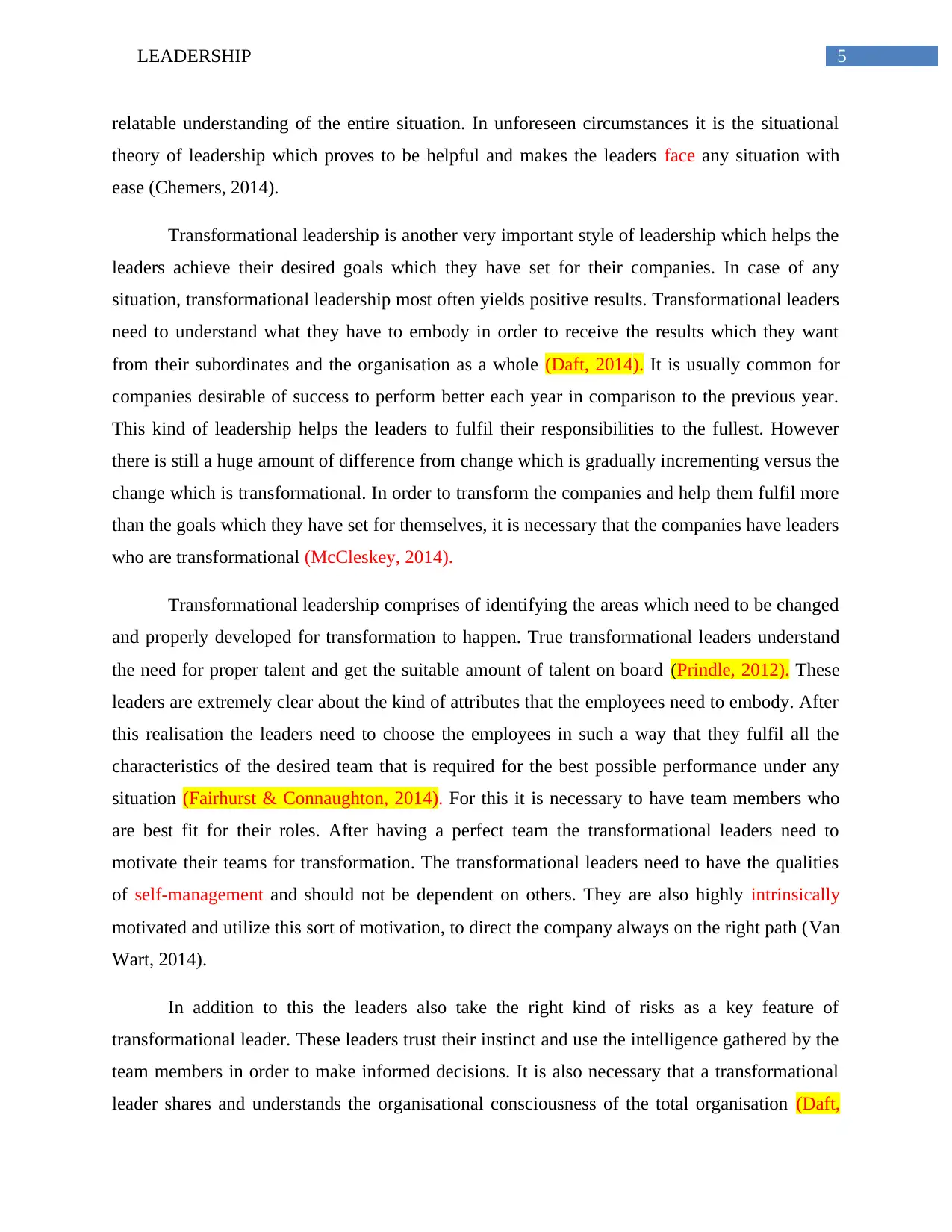
5LEADERSHIP
relatable understanding of the entire situation. In unforeseen circumstances it is the situational
theory of leadership which proves to be helpful and makes the leaders face any situation with
ease (Chemers, 2014).
Transformational leadership is another very important style of leadership which helps the
leaders achieve their desired goals which they have set for their companies. In case of any
situation, transformational leadership most often yields positive results. Transformational leaders
need to understand what they have to embody in order to receive the results which they want
from their subordinates and the organisation as a whole (Daft, 2014). It is usually common for
companies desirable of success to perform better each year in comparison to the previous year.
This kind of leadership helps the leaders to fulfil their responsibilities to the fullest. However
there is still a huge amount of difference from change which is gradually incrementing versus the
change which is transformational. In order to transform the companies and help them fulfil more
than the goals which they have set for themselves, it is necessary that the companies have leaders
who are transformational (McCleskey, 2014).
Transformational leadership comprises of identifying the areas which need to be changed
and properly developed for transformation to happen. True transformational leaders understand
the need for proper talent and get the suitable amount of talent on board (Prindle, 2012). These
leaders are extremely clear about the kind of attributes that the employees need to embody. After
this realisation the leaders need to choose the employees in such a way that they fulfil all the
characteristics of the desired team that is required for the best possible performance under any
situation (Fairhurst & Connaughton, 2014). For this it is necessary to have team members who
are best fit for their roles. After having a perfect team the transformational leaders need to
motivate their teams for transformation. The transformational leaders need to have the qualities
of self-management and should not be dependent on others. They are also highly intrinsically
motivated and utilize this sort of motivation, to direct the company always on the right path (Van
Wart, 2014).
In addition to this the leaders also take the right kind of risks as a key feature of
transformational leader. These leaders trust their instinct and use the intelligence gathered by the
team members in order to make informed decisions. It is also necessary that a transformational
leader shares and understands the organisational consciousness of the total organisation (Daft,
relatable understanding of the entire situation. In unforeseen circumstances it is the situational
theory of leadership which proves to be helpful and makes the leaders face any situation with
ease (Chemers, 2014).
Transformational leadership is another very important style of leadership which helps the
leaders achieve their desired goals which they have set for their companies. In case of any
situation, transformational leadership most often yields positive results. Transformational leaders
need to understand what they have to embody in order to receive the results which they want
from their subordinates and the organisation as a whole (Daft, 2014). It is usually common for
companies desirable of success to perform better each year in comparison to the previous year.
This kind of leadership helps the leaders to fulfil their responsibilities to the fullest. However
there is still a huge amount of difference from change which is gradually incrementing versus the
change which is transformational. In order to transform the companies and help them fulfil more
than the goals which they have set for themselves, it is necessary that the companies have leaders
who are transformational (McCleskey, 2014).
Transformational leadership comprises of identifying the areas which need to be changed
and properly developed for transformation to happen. True transformational leaders understand
the need for proper talent and get the suitable amount of talent on board (Prindle, 2012). These
leaders are extremely clear about the kind of attributes that the employees need to embody. After
this realisation the leaders need to choose the employees in such a way that they fulfil all the
characteristics of the desired team that is required for the best possible performance under any
situation (Fairhurst & Connaughton, 2014). For this it is necessary to have team members who
are best fit for their roles. After having a perfect team the transformational leaders need to
motivate their teams for transformation. The transformational leaders need to have the qualities
of self-management and should not be dependent on others. They are also highly intrinsically
motivated and utilize this sort of motivation, to direct the company always on the right path (Van
Wart, 2014).
In addition to this the leaders also take the right kind of risks as a key feature of
transformational leader. These leaders trust their instinct and use the intelligence gathered by the
team members in order to make informed decisions. It is also necessary that a transformational
leader shares and understands the organisational consciousness of the total organisation (Daft,
⊘ This is a preview!⊘
Do you want full access?
Subscribe today to unlock all pages.

Trusted by 1+ million students worldwide
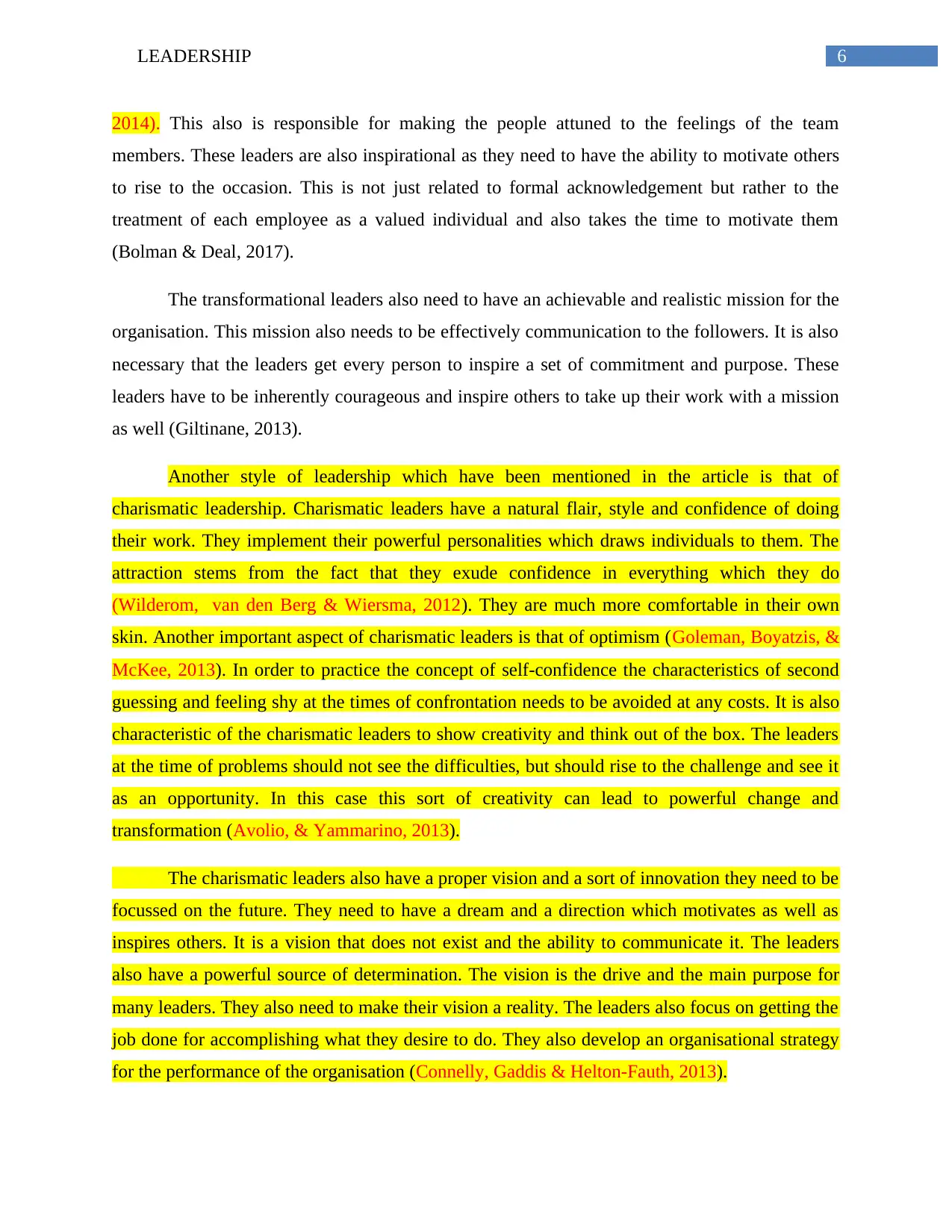
6LEADERSHIP
2014). This also is responsible for making the people attuned to the feelings of the team
members. These leaders are also inspirational as they need to have the ability to motivate others
to rise to the occasion. This is not just related to formal acknowledgement but rather to the
treatment of each employee as a valued individual and also takes the time to motivate them
(Bolman & Deal, 2017).
The transformational leaders also need to have an achievable and realistic mission for the
organisation. This mission also needs to be effectively communication to the followers. It is also
necessary that the leaders get every person to inspire a set of commitment and purpose. These
leaders have to be inherently courageous and inspire others to take up their work with a mission
as well (Giltinane, 2013).
Another style of leadership which have been mentioned in the article is that of
charismatic leadership. Charismatic leaders have a natural flair, style and confidence of doing
their work. They implement their powerful personalities which draws individuals to them. The
attraction stems from the fact that they exude confidence in everything which they do
(Wilderom, van den Berg & Wiersma, 2012). They are much more comfortable in their own
skin. Another important aspect of charismatic leaders is that of optimism (Goleman, Boyatzis, &
McKee, 2013). In order to practice the concept of self-confidence the characteristics of second
guessing and feeling shy at the times of confrontation needs to be avoided at any costs. It is also
characteristic of the charismatic leaders to show creativity and think out of the box. The leaders
at the time of problems should not see the difficulties, but should rise to the challenge and see it
as an opportunity. In this case this sort of creativity can lead to powerful change and
transformation (Avolio, & Yammarino, 2013).
The charismatic leaders also have a proper vision and a sort of innovation they need to be
focussed on the future. They need to have a dream and a direction which motivates as well as
inspires others. It is a vision that does not exist and the ability to communicate it. The leaders
also have a powerful source of determination. The vision is the drive and the main purpose for
many leaders. They also need to make their vision a reality. The leaders also focus on getting the
job done for accomplishing what they desire to do. They also develop an organisational strategy
for the performance of the organisation (Connelly, Gaddis & Helton-Fauth, 2013).
2014). This also is responsible for making the people attuned to the feelings of the team
members. These leaders are also inspirational as they need to have the ability to motivate others
to rise to the occasion. This is not just related to formal acknowledgement but rather to the
treatment of each employee as a valued individual and also takes the time to motivate them
(Bolman & Deal, 2017).
The transformational leaders also need to have an achievable and realistic mission for the
organisation. This mission also needs to be effectively communication to the followers. It is also
necessary that the leaders get every person to inspire a set of commitment and purpose. These
leaders have to be inherently courageous and inspire others to take up their work with a mission
as well (Giltinane, 2013).
Another style of leadership which have been mentioned in the article is that of
charismatic leadership. Charismatic leaders have a natural flair, style and confidence of doing
their work. They implement their powerful personalities which draws individuals to them. The
attraction stems from the fact that they exude confidence in everything which they do
(Wilderom, van den Berg & Wiersma, 2012). They are much more comfortable in their own
skin. Another important aspect of charismatic leaders is that of optimism (Goleman, Boyatzis, &
McKee, 2013). In order to practice the concept of self-confidence the characteristics of second
guessing and feeling shy at the times of confrontation needs to be avoided at any costs. It is also
characteristic of the charismatic leaders to show creativity and think out of the box. The leaders
at the time of problems should not see the difficulties, but should rise to the challenge and see it
as an opportunity. In this case this sort of creativity can lead to powerful change and
transformation (Avolio, & Yammarino, 2013).
The charismatic leaders also have a proper vision and a sort of innovation they need to be
focussed on the future. They need to have a dream and a direction which motivates as well as
inspires others. It is a vision that does not exist and the ability to communicate it. The leaders
also have a powerful source of determination. The vision is the drive and the main purpose for
many leaders. They also need to make their vision a reality. The leaders also focus on getting the
job done for accomplishing what they desire to do. They also develop an organisational strategy
for the performance of the organisation (Connelly, Gaddis & Helton-Fauth, 2013).
Paraphrase This Document
Need a fresh take? Get an instant paraphrase of this document with our AI Paraphraser
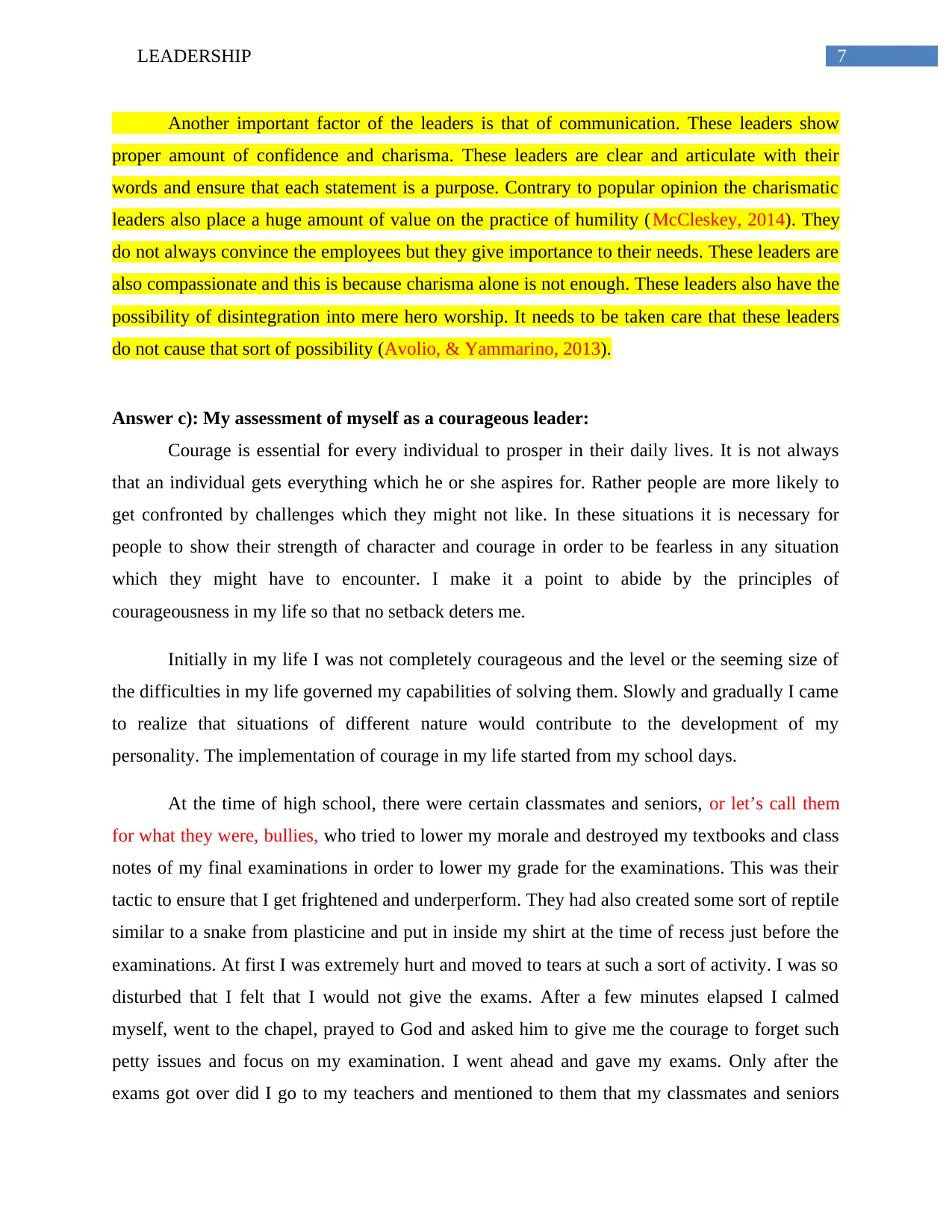
7LEADERSHIP
Another important factor of the leaders is that of communication. These leaders show
proper amount of confidence and charisma. These leaders are clear and articulate with their
words and ensure that each statement is a purpose. Contrary to popular opinion the charismatic
leaders also place a huge amount of value on the practice of humility (McCleskey, 2014). They
do not always convince the employees but they give importance to their needs. These leaders are
also compassionate and this is because charisma alone is not enough. These leaders also have the
possibility of disintegration into mere hero worship. It needs to be taken care that these leaders
do not cause that sort of possibility (Avolio, & Yammarino, 2013).
Answer c): My assessment of myself as a courageous leader:
Courage is essential for every individual to prosper in their daily lives. It is not always
that an individual gets everything which he or she aspires for. Rather people are more likely to
get confronted by challenges which they might not like. In these situations it is necessary for
people to show their strength of character and courage in order to be fearless in any situation
which they might have to encounter. I make it a point to abide by the principles of
courageousness in my life so that no setback deters me.
Initially in my life I was not completely courageous and the level or the seeming size of
the difficulties in my life governed my capabilities of solving them. Slowly and gradually I came
to realize that situations of different nature would contribute to the development of my
personality. The implementation of courage in my life started from my school days.
At the time of high school, there were certain classmates and seniors, or let’s call them
for what they were, bullies, who tried to lower my morale and destroyed my textbooks and class
notes of my final examinations in order to lower my grade for the examinations. This was their
tactic to ensure that I get frightened and underperform. They had also created some sort of reptile
similar to a snake from plasticine and put in inside my shirt at the time of recess just before the
examinations. At first I was extremely hurt and moved to tears at such a sort of activity. I was so
disturbed that I felt that I would not give the exams. After a few minutes elapsed I calmed
myself, went to the chapel, prayed to God and asked him to give me the courage to forget such
petty issues and focus on my examination. I went ahead and gave my exams. Only after the
exams got over did I go to my teachers and mentioned to them that my classmates and seniors
Another important factor of the leaders is that of communication. These leaders show
proper amount of confidence and charisma. These leaders are clear and articulate with their
words and ensure that each statement is a purpose. Contrary to popular opinion the charismatic
leaders also place a huge amount of value on the practice of humility (McCleskey, 2014). They
do not always convince the employees but they give importance to their needs. These leaders are
also compassionate and this is because charisma alone is not enough. These leaders also have the
possibility of disintegration into mere hero worship. It needs to be taken care that these leaders
do not cause that sort of possibility (Avolio, & Yammarino, 2013).
Answer c): My assessment of myself as a courageous leader:
Courage is essential for every individual to prosper in their daily lives. It is not always
that an individual gets everything which he or she aspires for. Rather people are more likely to
get confronted by challenges which they might not like. In these situations it is necessary for
people to show their strength of character and courage in order to be fearless in any situation
which they might have to encounter. I make it a point to abide by the principles of
courageousness in my life so that no setback deters me.
Initially in my life I was not completely courageous and the level or the seeming size of
the difficulties in my life governed my capabilities of solving them. Slowly and gradually I came
to realize that situations of different nature would contribute to the development of my
personality. The implementation of courage in my life started from my school days.
At the time of high school, there were certain classmates and seniors, or let’s call them
for what they were, bullies, who tried to lower my morale and destroyed my textbooks and class
notes of my final examinations in order to lower my grade for the examinations. This was their
tactic to ensure that I get frightened and underperform. They had also created some sort of reptile
similar to a snake from plasticine and put in inside my shirt at the time of recess just before the
examinations. At first I was extremely hurt and moved to tears at such a sort of activity. I was so
disturbed that I felt that I would not give the exams. After a few minutes elapsed I calmed
myself, went to the chapel, prayed to God and asked him to give me the courage to forget such
petty issues and focus on my examination. I went ahead and gave my exams. Only after the
exams got over did I go to my teachers and mentioned to them that my classmates and seniors
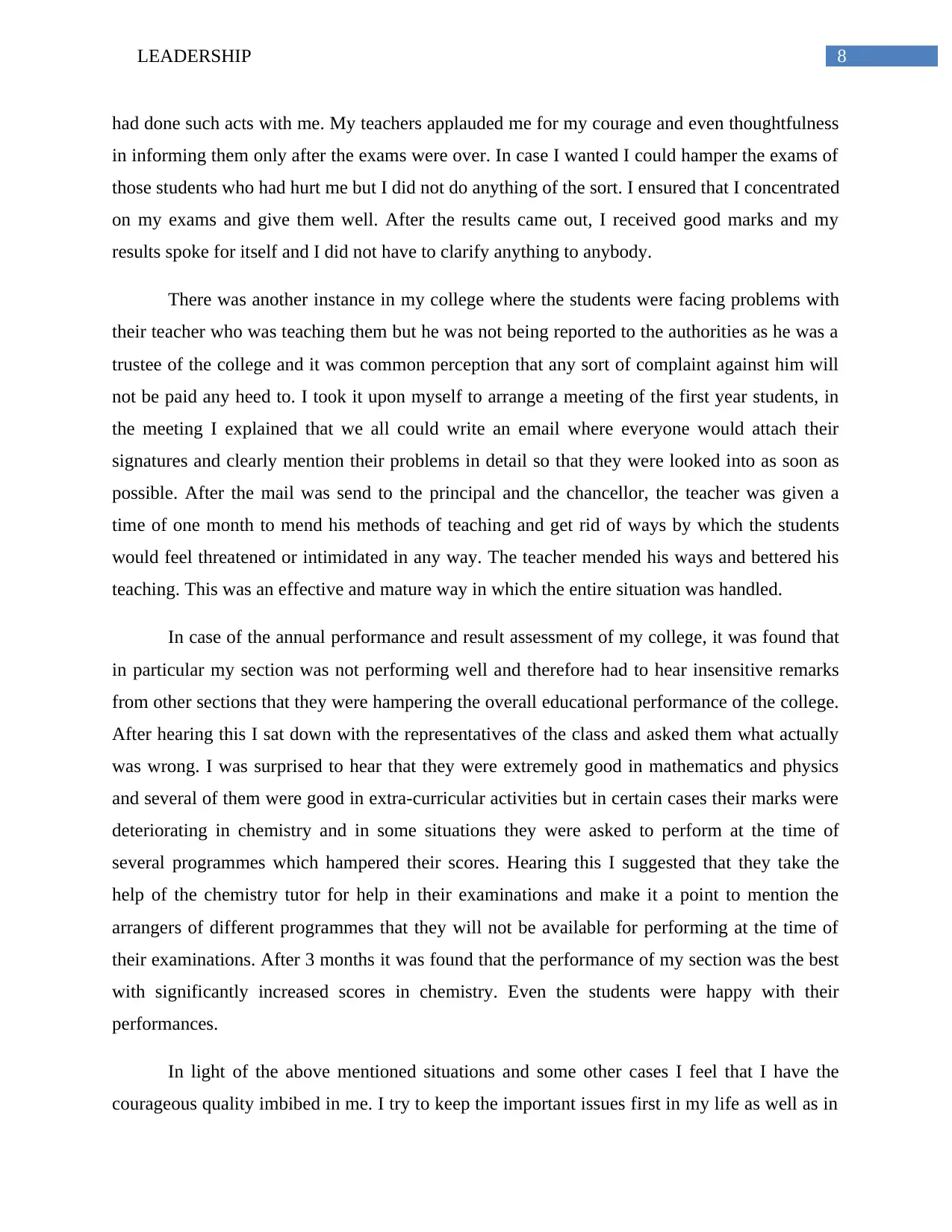
8LEADERSHIP
had done such acts with me. My teachers applauded me for my courage and even thoughtfulness
in informing them only after the exams were over. In case I wanted I could hamper the exams of
those students who had hurt me but I did not do anything of the sort. I ensured that I concentrated
on my exams and give them well. After the results came out, I received good marks and my
results spoke for itself and I did not have to clarify anything to anybody.
There was another instance in my college where the students were facing problems with
their teacher who was teaching them but he was not being reported to the authorities as he was a
trustee of the college and it was common perception that any sort of complaint against him will
not be paid any heed to. I took it upon myself to arrange a meeting of the first year students, in
the meeting I explained that we all could write an email where everyone would attach their
signatures and clearly mention their problems in detail so that they were looked into as soon as
possible. After the mail was send to the principal and the chancellor, the teacher was given a
time of one month to mend his methods of teaching and get rid of ways by which the students
would feel threatened or intimidated in any way. The teacher mended his ways and bettered his
teaching. This was an effective and mature way in which the entire situation was handled.
In case of the annual performance and result assessment of my college, it was found that
in particular my section was not performing well and therefore had to hear insensitive remarks
from other sections that they were hampering the overall educational performance of the college.
After hearing this I sat down with the representatives of the class and asked them what actually
was wrong. I was surprised to hear that they were extremely good in mathematics and physics
and several of them were good in extra-curricular activities but in certain cases their marks were
deteriorating in chemistry and in some situations they were asked to perform at the time of
several programmes which hampered their scores. Hearing this I suggested that they take the
help of the chemistry tutor for help in their examinations and make it a point to mention the
arrangers of different programmes that they will not be available for performing at the time of
their examinations. After 3 months it was found that the performance of my section was the best
with significantly increased scores in chemistry. Even the students were happy with their
performances.
In light of the above mentioned situations and some other cases I feel that I have the
courageous quality imbibed in me. I try to keep the important issues first in my life as well as in
had done such acts with me. My teachers applauded me for my courage and even thoughtfulness
in informing them only after the exams were over. In case I wanted I could hamper the exams of
those students who had hurt me but I did not do anything of the sort. I ensured that I concentrated
on my exams and give them well. After the results came out, I received good marks and my
results spoke for itself and I did not have to clarify anything to anybody.
There was another instance in my college where the students were facing problems with
their teacher who was teaching them but he was not being reported to the authorities as he was a
trustee of the college and it was common perception that any sort of complaint against him will
not be paid any heed to. I took it upon myself to arrange a meeting of the first year students, in
the meeting I explained that we all could write an email where everyone would attach their
signatures and clearly mention their problems in detail so that they were looked into as soon as
possible. After the mail was send to the principal and the chancellor, the teacher was given a
time of one month to mend his methods of teaching and get rid of ways by which the students
would feel threatened or intimidated in any way. The teacher mended his ways and bettered his
teaching. This was an effective and mature way in which the entire situation was handled.
In case of the annual performance and result assessment of my college, it was found that
in particular my section was not performing well and therefore had to hear insensitive remarks
from other sections that they were hampering the overall educational performance of the college.
After hearing this I sat down with the representatives of the class and asked them what actually
was wrong. I was surprised to hear that they were extremely good in mathematics and physics
and several of them were good in extra-curricular activities but in certain cases their marks were
deteriorating in chemistry and in some situations they were asked to perform at the time of
several programmes which hampered their scores. Hearing this I suggested that they take the
help of the chemistry tutor for help in their examinations and make it a point to mention the
arrangers of different programmes that they will not be available for performing at the time of
their examinations. After 3 months it was found that the performance of my section was the best
with significantly increased scores in chemistry. Even the students were happy with their
performances.
In light of the above mentioned situations and some other cases I feel that I have the
courageous quality imbibed in me. I try to keep the important issues first in my life as well as in
⊘ This is a preview!⊘
Do you want full access?
Subscribe today to unlock all pages.

Trusted by 1+ million students worldwide
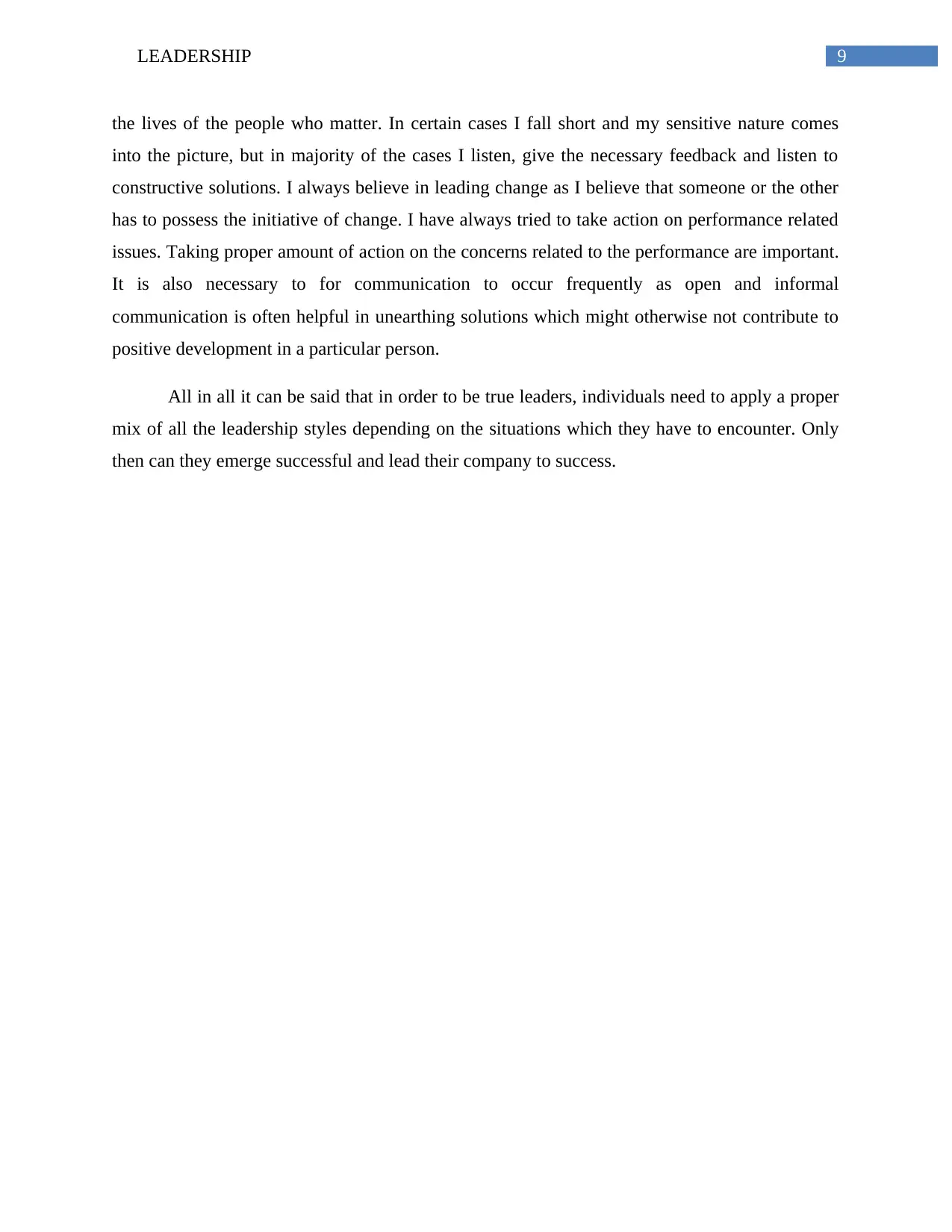
9LEADERSHIP
the lives of the people who matter. In certain cases I fall short and my sensitive nature comes
into the picture, but in majority of the cases I listen, give the necessary feedback and listen to
constructive solutions. I always believe in leading change as I believe that someone or the other
has to possess the initiative of change. I have always tried to take action on performance related
issues. Taking proper amount of action on the concerns related to the performance are important.
It is also necessary to for communication to occur frequently as open and informal
communication is often helpful in unearthing solutions which might otherwise not contribute to
positive development in a particular person.
All in all it can be said that in order to be true leaders, individuals need to apply a proper
mix of all the leadership styles depending on the situations which they have to encounter. Only
then can they emerge successful and lead their company to success.
the lives of the people who matter. In certain cases I fall short and my sensitive nature comes
into the picture, but in majority of the cases I listen, give the necessary feedback and listen to
constructive solutions. I always believe in leading change as I believe that someone or the other
has to possess the initiative of change. I have always tried to take action on performance related
issues. Taking proper amount of action on the concerns related to the performance are important.
It is also necessary to for communication to occur frequently as open and informal
communication is often helpful in unearthing solutions which might otherwise not contribute to
positive development in a particular person.
All in all it can be said that in order to be true leaders, individuals need to apply a proper
mix of all the leadership styles depending on the situations which they have to encounter. Only
then can they emerge successful and lead their company to success.
Paraphrase This Document
Need a fresh take? Get an instant paraphrase of this document with our AI Paraphraser
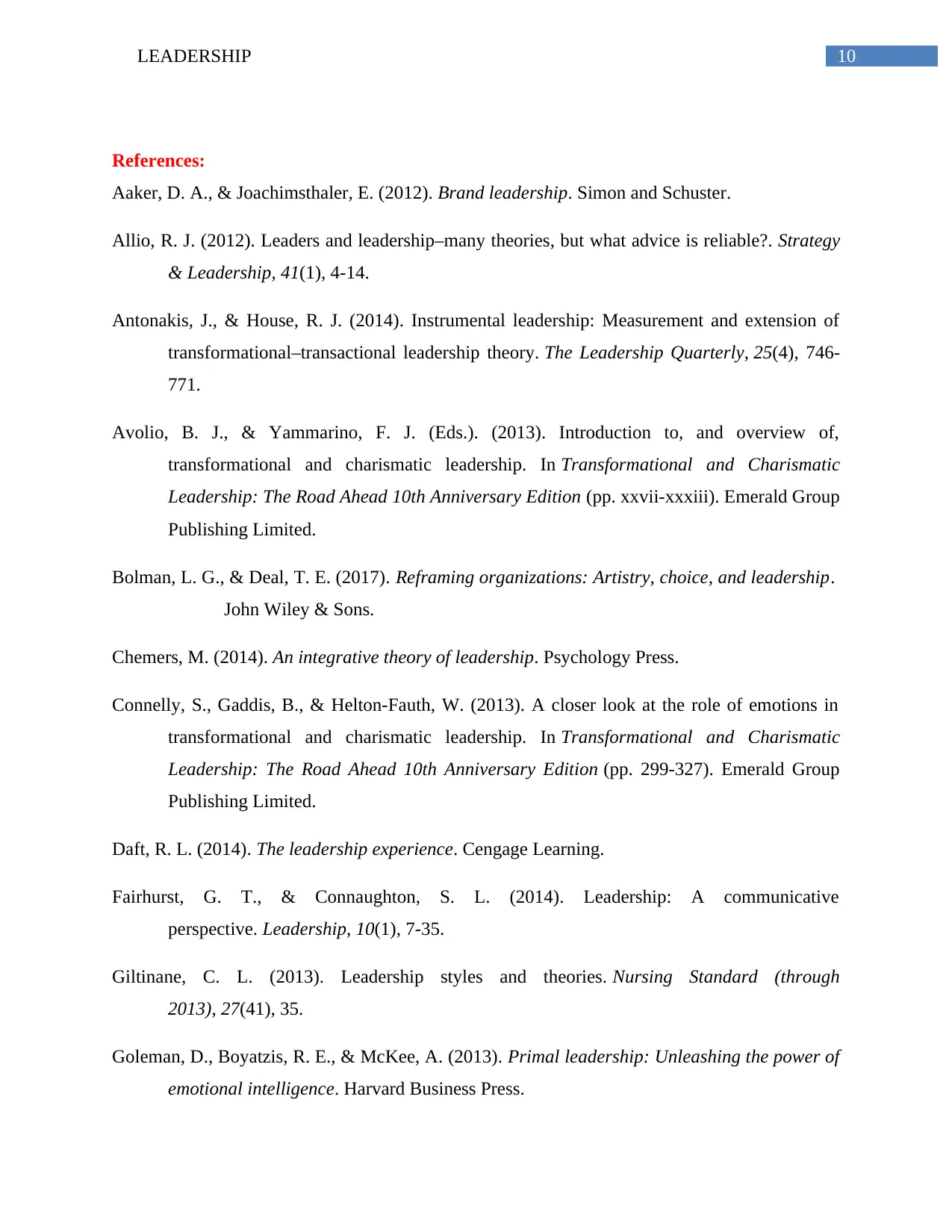
10LEADERSHIP
References:
Aaker, D. A., & Joachimsthaler, E. (2012). Brand leadership. Simon and Schuster.
Allio, R. J. (2012). Leaders and leadership–many theories, but what advice is reliable?. Strategy
& Leadership, 41(1), 4-14.
Antonakis, J., & House, R. J. (2014). Instrumental leadership: Measurement and extension of
transformational–transactional leadership theory. The Leadership Quarterly, 25(4), 746-
771.
Avolio, B. J., & Yammarino, F. J. (Eds.). (2013). Introduction to, and overview of,
transformational and charismatic leadership. In Transformational and Charismatic
Leadership: The Road Ahead 10th Anniversary Edition (pp. xxvii-xxxiii). Emerald Group
Publishing Limited.
Bolman, L. G., & Deal, T. E. (2017). Reframing organizations: Artistry, choice, and leadership.
John Wiley & Sons.
Chemers, M. (2014). An integrative theory of leadership. Psychology Press.
Connelly, S., Gaddis, B., & Helton-Fauth, W. (2013). A closer look at the role of emotions in
transformational and charismatic leadership. In Transformational and Charismatic
Leadership: The Road Ahead 10th Anniversary Edition (pp. 299-327). Emerald Group
Publishing Limited.
Daft, R. L. (2014). The leadership experience. Cengage Learning.
Fairhurst, G. T., & Connaughton, S. L. (2014). Leadership: A communicative
perspective. Leadership, 10(1), 7-35.
Giltinane, C. L. (2013). Leadership styles and theories. Nursing Standard (through
2013), 27(41), 35.
Goleman, D., Boyatzis, R. E., & McKee, A. (2013). Primal leadership: Unleashing the power of
emotional intelligence. Harvard Business Press.
References:
Aaker, D. A., & Joachimsthaler, E. (2012). Brand leadership. Simon and Schuster.
Allio, R. J. (2012). Leaders and leadership–many theories, but what advice is reliable?. Strategy
& Leadership, 41(1), 4-14.
Antonakis, J., & House, R. J. (2014). Instrumental leadership: Measurement and extension of
transformational–transactional leadership theory. The Leadership Quarterly, 25(4), 746-
771.
Avolio, B. J., & Yammarino, F. J. (Eds.). (2013). Introduction to, and overview of,
transformational and charismatic leadership. In Transformational and Charismatic
Leadership: The Road Ahead 10th Anniversary Edition (pp. xxvii-xxxiii). Emerald Group
Publishing Limited.
Bolman, L. G., & Deal, T. E. (2017). Reframing organizations: Artistry, choice, and leadership.
John Wiley & Sons.
Chemers, M. (2014). An integrative theory of leadership. Psychology Press.
Connelly, S., Gaddis, B., & Helton-Fauth, W. (2013). A closer look at the role of emotions in
transformational and charismatic leadership. In Transformational and Charismatic
Leadership: The Road Ahead 10th Anniversary Edition (pp. 299-327). Emerald Group
Publishing Limited.
Daft, R. L. (2014). The leadership experience. Cengage Learning.
Fairhurst, G. T., & Connaughton, S. L. (2014). Leadership: A communicative
perspective. Leadership, 10(1), 7-35.
Giltinane, C. L. (2013). Leadership styles and theories. Nursing Standard (through
2013), 27(41), 35.
Goleman, D., Boyatzis, R. E., & McKee, A. (2013). Primal leadership: Unleashing the power of
emotional intelligence. Harvard Business Press.
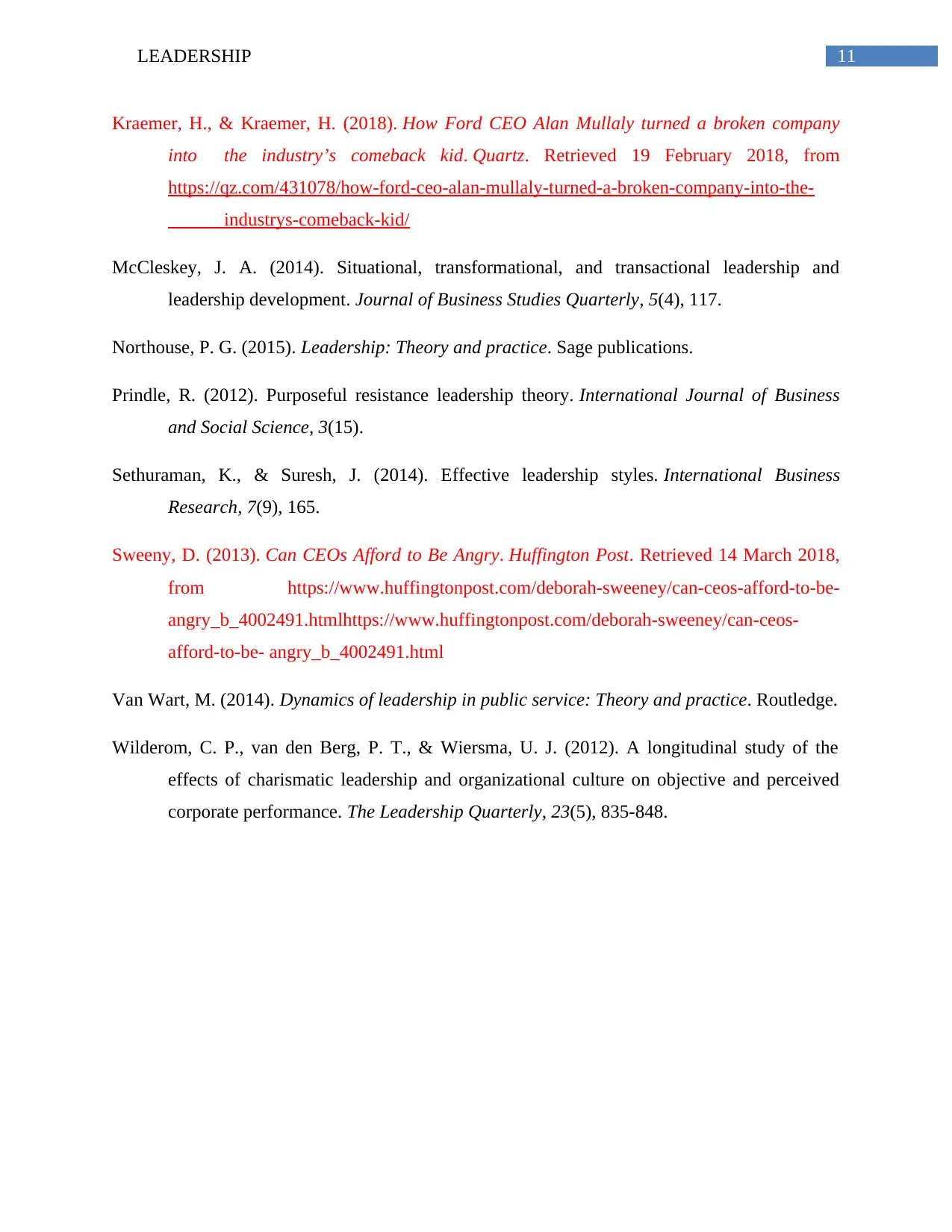
11LEADERSHIP
Kraemer, H., & Kraemer, H. (2018). How Ford CEO Alan Mullaly turned a broken company
into the industry’s comeback kid. Quartz. Retrieved 19 February 2018, from
https://qz.com/431078/how-ford-ceo-alan-mullaly-turned-a-broken-company-into-the-
industrys-comeback-kid/
McCleskey, J. A. (2014). Situational, transformational, and transactional leadership and
leadership development. Journal of Business Studies Quarterly, 5(4), 117.
Northouse, P. G. (2015). Leadership: Theory and practice. Sage publications.
Prindle, R. (2012). Purposeful resistance leadership theory. International Journal of Business
and Social Science, 3(15).
Sethuraman, K., & Suresh, J. (2014). Effective leadership styles. International Business
Research, 7(9), 165.
Sweeny, D. (2013). Can CEOs Afford to Be Angry. Huffington Post. Retrieved 14 March 2018,
from https://www.huffingtonpost.com/deborah-sweeney/can-ceos-afford-to-be-
angry_b_4002491.htmlhttps://www.huffingtonpost.com/deborah-sweeney/can-ceos-
afford-to-be- angry_b_4002491.html
Van Wart, M. (2014). Dynamics of leadership in public service: Theory and practice. Routledge.
Wilderom, C. P., van den Berg, P. T., & Wiersma, U. J. (2012). A longitudinal study of the
effects of charismatic leadership and organizational culture on objective and perceived
corporate performance. The Leadership Quarterly, 23(5), 835-848.
Kraemer, H., & Kraemer, H. (2018). How Ford CEO Alan Mullaly turned a broken company
into the industry’s comeback kid. Quartz. Retrieved 19 February 2018, from
https://qz.com/431078/how-ford-ceo-alan-mullaly-turned-a-broken-company-into-the-
industrys-comeback-kid/
McCleskey, J. A. (2014). Situational, transformational, and transactional leadership and
leadership development. Journal of Business Studies Quarterly, 5(4), 117.
Northouse, P. G. (2015). Leadership: Theory and practice. Sage publications.
Prindle, R. (2012). Purposeful resistance leadership theory. International Journal of Business
and Social Science, 3(15).
Sethuraman, K., & Suresh, J. (2014). Effective leadership styles. International Business
Research, 7(9), 165.
Sweeny, D. (2013). Can CEOs Afford to Be Angry. Huffington Post. Retrieved 14 March 2018,
from https://www.huffingtonpost.com/deborah-sweeney/can-ceos-afford-to-be-
angry_b_4002491.htmlhttps://www.huffingtonpost.com/deborah-sweeney/can-ceos-
afford-to-be- angry_b_4002491.html
Van Wart, M. (2014). Dynamics of leadership in public service: Theory and practice. Routledge.
Wilderom, C. P., van den Berg, P. T., & Wiersma, U. J. (2012). A longitudinal study of the
effects of charismatic leadership and organizational culture on objective and perceived
corporate performance. The Leadership Quarterly, 23(5), 835-848.
⊘ This is a preview!⊘
Do you want full access?
Subscribe today to unlock all pages.

Trusted by 1+ million students worldwide
1 out of 12
Related Documents
Your All-in-One AI-Powered Toolkit for Academic Success.
+13062052269
info@desklib.com
Available 24*7 on WhatsApp / Email
![[object Object]](/_next/static/media/star-bottom.7253800d.svg)
Unlock your academic potential
Copyright © 2020–2025 A2Z Services. All Rights Reserved. Developed and managed by ZUCOL.





